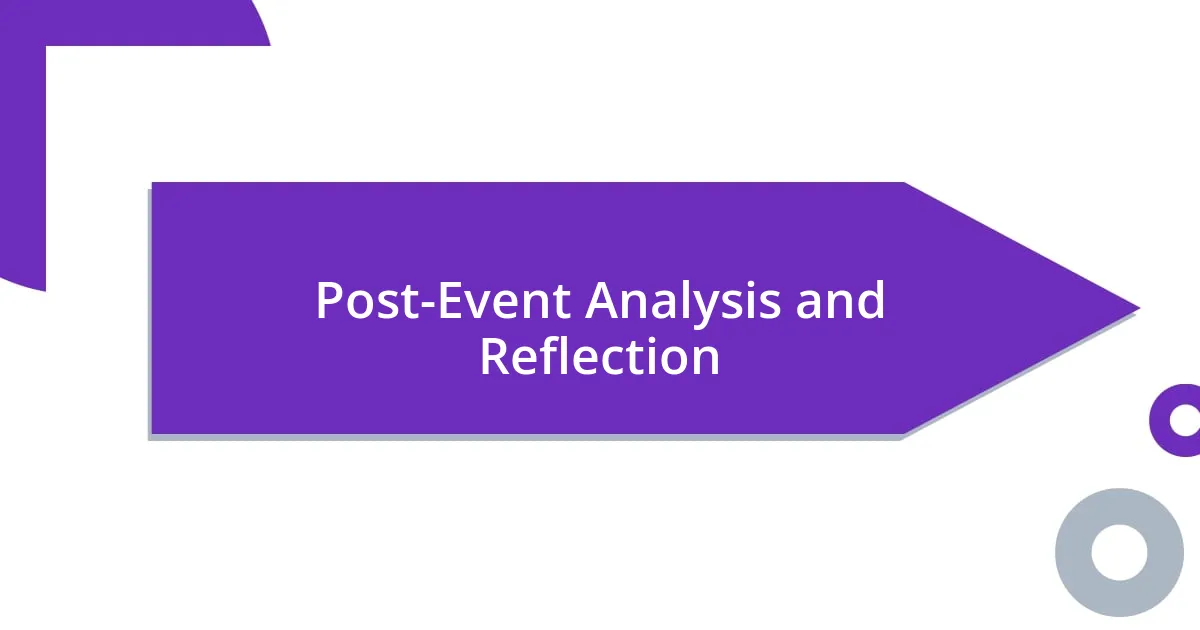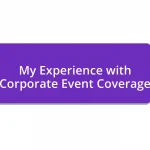Key takeaways:
- Effective outdoor event coverage requires understanding the atmosphere and connecting with attendees to enhance storytelling.
- Preparation is key; create checklists and prioritize essential equipment, including weather gear and audio recording devices.
- Engagement with the audience through personal interactions and encouraging social media sharing can enrich coverage and broaden event reach.
- Post-event reflection and feedback gathering are crucial for improving future coverage and honing storytelling skills.

Understanding Outdoor Event Coverage
Understanding outdoor event coverage means grasping the atmosphere of the moment. I remember covering a local music festival, feeling the energy in the air as artists took the stage. Those fleeting moments of excitement are what make effective coverage not just about the event itself, but about capturing the spirit that draws people together.
When I think about the logistics of outdoor events, it’s clear that planning is key. Have you ever tried to set up a booth in unpredictable weather? I have! That day, the sun was shining one minute and pouring rain the next. Being prepared with flexible strategies helped me adapt and ensured I could document every important detail without getting sidelined by the elements.
Connecting with the audience is crucial in outdoor coverage. During another event, I found myself chatting with attendees about their experiences. These personal interactions brought added depth to my coverage, revealing how the event impacted them emotionally. It’s those stories and the laughter shared that make an event truly memorable beyond just the visuals.

Preparing for Outdoor Events
When preparing for outdoor events, I always make a checklist to ensure I don’t overlook any details. For instance, at a food festival I once covered, I needed not only my camera gear but also sunscreen and hydration. It sounds simple, but those items became my best friends on a sweltering day!
Here’s a quick preparation list based on my experience:
– Weather Conditions: Check forecasts and plan for sun, rain, or wind.
– Equipment Check: Ensure all gear is functioning well, and don’t forget backup batteries!
– Comfort Supplies: Bring items like sunscreen, water, and snacks to keep your energy up.
– Logistics: Know the event layout so you can easily navigate between key areas.
– Contact Information: Keep a list of important contacts for the event’s organizers or fellow vendors.
Every detail counts, and those little preparations can save you from unexpected surprises that might otherwise derail your day!

Essential Equipment for Outdoor Events
When it comes to essential equipment for outdoor events, I can’t overstress the importance of having the right gear. On one occasion, I arrived at a community fair feeling prepared with my camera, lenses, and even a tripod. However, when I saw how bright the sunshine was, I realized I should have packed a reflector to combat harsh shadows—it was a lesson I learned the hard way! After that experience, I always carry a variety of tools to adapt to different lighting and conditions.
I also think it’s crucial to invest in quality audio equipment if the event includes speakers or live music. I remember one festival where the sound was poorly set up, and it made capturing the moment a real challenge. Utilizing a portable audio recorder can significantly enhance your coverage, allowing you to capture the atmosphere and dialogue clearly. Being able to relive those emotional speeches or heartfelt performances later really adds richness to your storytelling.
From my experience, I’ve compiled a short comparison table highlighting essential equipment for outdoor events based on my personal needs and insights:
| Equipment | Purpose |
|---|---|
| Camera Gear | Captures high-quality images |
| Audio Recorder | Records clear sound for speeches and performances |
| Portable Charger | Keeps devices powered throughout long events |
| Weather Gear | Protects equipment and yourself from unexpected elements |
| Comfort Essentials | Keeps you energized and focused, such as snacks and water |
Having a well-rounded selection of equipment can make all the difference in effectively covering outdoor events.

Successful Event Coverage Techniques
While covering outdoor events, I’ve found that having a solid approach to capturing the moment is essential. One technique that’s served me well is scouting the venue early. I remember arriving at a local music festival before the crowds gathered and quietly observing the stages and flow of people. This advance knowledge allowed me to position myself perfectly to capture those breathtaking candid moments when the artists took the stage and the audience erupted in cheers. Isn’t it incredible how a little foresight can lead to stunning shots?
Another technique I swear by is staying flexible and adapting to the environment. I once attended a charity run where the weather took an unexpected turn, throwing a curveball into my plans. Instead of panicking, I quickly shifted my focus to the expressions of determination on participants’ faces as they braved the rain. By adjusting my approach, I ended up capturing some of the most powerful images of resilience and camaraderie, which resonated deeply with the event’s theme. Have you ever faced a situation that forced you to think on your feet? It can lead to unforgettable outcomes.
Lastly, engaging with attendees and speakers on a personal level enhances coverage immeasurably. I vividly recall chatting briefly with a participant at a community fair who shared their motivation for joining in. By including their story in my write-up, I added depth that would’ve been missing otherwise. This connection not only made my content richer but also demonstrated how powerful sharing experiences can be. Don’t you think that personal stories bring life to any coverage? As I’ve learned, every voice counts, and weaving those narratives into your coverage turns simple reporting into compelling storytelling.

Engaging with the Audience
When I think about engaging with the audience, I can’t help but recall a moment at a local art festival. I had just finished capturing a vibrant piece when a little boy approached me, eyes wide with excitement. His enthusiasm was infectious! I took a moment to chat with him about his favorite artwork, and it not only added a personal touch to my coverage but also made the event feel more alive—the vibrant energy of the crowd really boosted my own creativity.
One technique that’s worked wonders for me involves asking attendees open-ended questions. I remember covering a food festival and struck up a conversation with a vendor about the inspiration behind their unique dishes. By including quotes from passionate individuals in my work, I find the narrative transforms from mere facts to a story that resonates emotionally. Have you ever noticed how a simple conversation can lead to deeper insights? Those genuine interactions often reveal the heart of an event.
Another aspect of engaging with the audience that I find enriching is encouraging them to share their experiences on social media. During a charity marathon I covered, I urged participants to capture their personal moments and tag the event’s hashtag. The result? A delightful array of perspectives that added texture to my coverage! It’s always a joy to see how a shared experience can resonate differently with each person. I believe that fostering this community involvement not only broadens the reach of the event but creates a memorable tapestry of emotions and stories.

Post-Event Analysis and Reflection
After an outdoor event, I always find it essential to take a moment and reflect on what transpired. I recall a vibrant music festival where, at the end of the day, I sat on the grass with my notebook, jotting down my thoughts. This practice helped me see beyond the surface—the emotional highs and the low moments, the energy of the crowd, and even the small details that would later enrich my storytelling. Have you ever found yourself thinking about an event well after it’s over, piecing together the narrative of what made it memorable?
Additionally, I prioritize gathering feedback from the organizers and attendees. A few days after covering a local fair, I reached out to the event coordinator, eager to hear their thoughts on how things went. Their insights highlighted aspects of the event I hadn’t considered—like how certain logistical challenges impacted attendee experience. Engaging in this dialogue not only helps improve my future coverage but also deepens my understanding of the event dynamics. How valuable insight can be when it comes to honing our craft!
Finally, I always make it a point to review my footage and photos critically. On one occasion, after a nature run, I noticed that while I had captured energetic action shots, I had missed the quieter moments of reflection by the riverbank. This reflection led me to prioritize these quieter, yet intimate captures in future projects. It’s fascinating how a single oversight can transform your perspective and approach to event coverage—what lessons have you taken away from your own experiences?

Building a Portfolio from Events
When it comes to building a portfolio from events, I think showcasing a variety of experiences is crucial. I vividly remember covering a community sports day where I captured everything from the fierce competition to the heartwarming moments of teamwork. By including a diverse range of images and stories, I was able to create an engaging narrative that not only highlighted the event but also showcased my versatility as a photographer and storyteller. Don’t you agree that variety adds depth to a portfolio?
One strategy I’ve found effective is to develop a dedicated project or series based on an event theme. For instance, after documenting a local music festival, I compiled a collection focusing on the emotional expressions of performers and audience members alike. This allowed me to tell a richer story and establish a recognizable style. Have you ever thought about how thematic consistency can elevate your work? It’s a game-changer in making a portfolio not just a collection, but a cohesive glimpse into your artistic vision.
Lastly, I always encourage capturing behind-the-scenes moments, as they can provide a unique perspective that’s often overlooked. During a charity run, I had the chance to photograph volunteers setting up, which added a layer of authenticity to my portfolio. Seeing the effort that goes into making an event happen is not only inspiring but speaks to the heart of storytelling. How many times have you looked back and wished you had documented those unsung heroes on site? These candid moments can transform an ordinary portfolio into something truly special.














